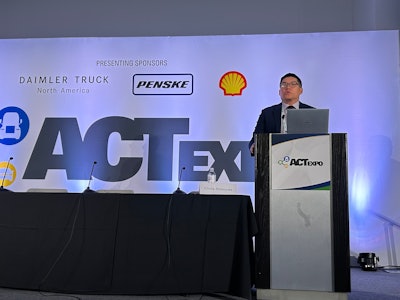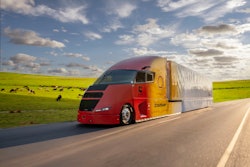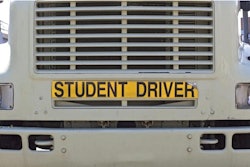
California has for many years been the epicenter for clean air regulatory reform, often pushing through strict standards that exceed federal requirements. That has, at times, put California’s Air Resources Board (CARB) and the Environmental Protection Agency (EPA) at odds, with motor carriers operating in the state caught in the crossfire.
“This transition to zero emission technology is a brand-new issue for the industry,” said California Trucking Association Senior Vice President of Government Affairs Chris Shimoda, who kicked off a regulatory workshop the Advanced Clean Transportation (ACT) Expo in Las Vegas Monday. “This is the biggest revolution in how our nation’s supply chain operates in over 70 years – since the advent of the diesel engine.”
[Related: How California's Advanced Clean Fleets regs impact businesses]
Tom Swenson, director of global regulatory affairs at Cummins, noted that “there are lots and lots you have to deal with both in California and nationally,” and staying compliant with California regulations, Shimoda said, is a full-time job, “and I know that because it’s my full-time job.”
Companies with the financial resources to do so have stood up entire compliance departments, while smaller fleets have tacked this responsibility onto existing job descriptions. In either case, Shimoda said it’s important to seek out partners and feedback wherever you can find them.
“Expert help is necessary. There are too many rules that are constantly changing to go at it alone. There is a strong return on investment in seeking expert help,” he added, citing high upfront expenses and costs associated with non-compliance.
“You really need to have a partner in this space,” said Ryan Bankerd, UPS director of automotive sustainability. Bankerd added that UPS also used expert consultants despite its own internal resources, as third-party expertise can help uncover hidden opportunities.
“Fleets have to be excited about some of the beachhead technologies,” said Bankerd. He said beachhead technologies can be things like electric yard spotters that allow fleets to wade into zero emissions and determine how it might fit into their operations. “You’re going to have these beachheads that you can evolve and integrate from there.”
What is in play?
 Tom Swenson, director of global regulatory affairs at Cummins.
Tom Swenson, director of global regulatory affairs at Cummins.
CARB in 2020 adopted the first zero emissions sales mandate. Under the Advanced Clean Trucks (ACT) rule, makers of commercial trucks have to sell an increasing percentage of zero emission trucks, leading to an eventual ban of internal combustion engine (ICE) trucks in 2036. The state was granted an EPA waiver to enforce the rule. It has been challenged in the D.C. Circuit, yet Shimdoa pointed out that “no matter what happens, manufactures are pursuant to an agreement, having committed to complying to the ACT,” an agreement that aligned CARB and EPA tailpipe standards.
[Related: States challenge latest EPA, CARB truck emissions rules]
Harbor Trucking Association CEO Matt Schrap’s organization represents port carriers, among the groups most immediately impacted by zero emission mandates, as effective this year any new registered ICE trucks can be removed from service. By 2035, all drayage trucks operating at California’s seaports and intermodal railyards are required to be zero emission.
The Advanced Clean Fleets (ACF) rule was adopted by CARB last year with effective date of January 2024, but CTA filed litigation last year and in December agreed with CARB to stay enforcement on private motor carriers pending an EPA waiver.
Schrap’s members are currently covered by a stay of enforcement but that doesn’t ease the uncertainty of adding new trucks that could be immediately removed from service once a formal waiver is granted. Still, Schrap said it’s important to understand that no one in transportation is opposed to clean air regulations, rather it is the express timeframe for adoption of technology.
“It’s not the why, it’s the how,” he said. “If this technology is so great, you don’t need a rule to force fleets to use it.”
When will ACF come into effect? Shimoda said no one can say for certain, but it’s “likely safe to say not within the next six months,” he said, adding legal controversies will not end with waivers.
Amid all the legislative uncertainty, Shimoda said, “it is time for us to collectively perform due diligence on the cost and implementation of zero emissions,” and for carriers that determine there is no smart business case for a zero-emission conversion, Shimoda said not to panic.
“If history is any indication, these regulations will change over time,” he said, adding given the heavy infrastructure lift and equipment needs on all sides, “it was also unlikely that we would get it right straight away."












